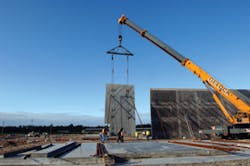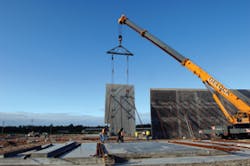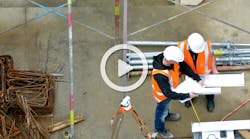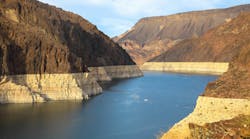Providing a Financial Boost and Water Conservation
The numbers tell the story: Michigan’s unemployment rate soared to 12.6% in March, according to the US Bureau of Labor Statistics. No other state has a higher rate. The state’s auto industry, its economic engine for so long, is teetering. RealtyTrac, an online collector of foreclosure data, says that Michigan had the sixth-highest number of housing foreclosures in the country during the first quarter of the month.
And to make matters even worse, the state’s fiscal year 2009 budget deficit is expected to rise to nearly $1.3 billion. That’s a big, depressing hike from one year earlier, when the state’s deficit stood at $785 million, according to a story by the Reuters news service.
Any good news, then, is a relief. And the April opening of a $16-million beer distribution center in Bay County, MI, certainly qualifies. Not only does Fabiano Brothers Inc.’s new distribution center employ about 280 workers, it also shows skeptics that new business is being conducted in the struggling state.
In addition to its water reclamation system, The Fabiano Bros.’ 191,000–square foot distribution center boasts a number of other energy-saving features.
The new distribution center provides some welcome news to proponents of water conservation: The Fabiano Bros.’ 191,000–square foot distribution center, which is located about four miles outside of the Central Michigan community of Bay City, also features an innovative water reclamation system in its truck-washing facility. By using the system, a SoBrite Filtermatic 3B, employees are able to reuse the water they spend to wash the distribution center’s fleet of beer trucks, minivans, and other vehicles.
It’s estimated that Fabiano Brothers will now use 70% less water in its truck-washing bays, thanks to its new water reclamation system.
That translates into dollar savings, a necessity in today’s economy for any company.
“Washing your trucks is not a revenue-producing activity. But it’s something a company like Fabiano Brothers has to do,” says Bryant Ruder, general manager at Eureka, IL-based SoBrite, the manufacturer of the distribution center’s water reclamation system. “The big question, then, is, “˜How do I make money doing this?’ Well, they may not be able to make money washing the trucks, but by saving 70% or more of their water, that does change the cash flow positively. It makes washing the trucks much less of a financial burden.”
Though washing the trucks is not a revenue-producing activity, it is an important one. Clean trucks boost a company’s image. Running a clean fleet is also one tool in preventing unnecessary, and costly, repairs. It also helps keep trucks on the road, where they are generating income for the company.Ruder says that Fabiano Brothers by reusing the water from its washing bays is saving money in two ways: Water can cost from $3 to $4 for every 1,000 gallons purchased from a providing municipality. When Fabiano Bros. reuses the water in its truck-washing bays, cutting water usage by as much as 70%, it adds up to big savings very quickly, Ruder says.
At the same time, the distribution center will save money on its sewer bill, he adds. A sewer bill is higher for facilities that purchase greater quantities of city water. By cutting its water use, the distribution center, then, will also lower the amount of money it pays the city for processing and treating the water that leaves its site, Ruder says.
“If you’re in business and you are washing your fleet vehicles as part of that business, using a system like this continuously pays you back,” says Ruder. “People often say that if something doesn’t pay you back in 18 to 24 months, it’s not worth doing. That may be true in most applications. But if you are washing a lot of vehicles, you should consider a water reclamation system as part of your business’ foundation.”
A Big Impact in a Struggling State
Construction on the Fabiano Brothers facility began in September 2007. With the completion of the facility in early April, the beer and spirits distributor was able to consolidate its corporate headquarters and beer distribution facility in one location. The company, though, is still using a facility in nearby Saginaw, MI, for its wine-distribution business.
And while the distribution center itself is good news for a state desperate for any new economic development, the Fabiano Brothers facility might be just the first bit of new commercial construction at the site. Plans call for the facility to serve as the anchor of a newly developed 71-acre business park in Monitor Township, MI. Fabiano Bros. plans to sell lots in the new center, dubbed the Market Place Corporate Center, to other businesses.
Andrew Sitton, director of architecture with HDA Architects of Chesterfield, MO served as the project director on the Fabiano Brothers facility. The project, he says, has already made a positive impact on Bay County.
“This is a huge project for the local county,” says Sitton. “They employ a lot of people at Fabiano Brothers. To be in a situation like the state of Michigan is in, it is so important to have a project like this come to fruition in rough times. I know they used local construction workers as much as possible when building the facility. I think it is real important for the community to have a project like this in the region.”
In addition to its water reclamation system, the distribution center boasts a number of other energy-saving features, Sitton says.
The warehouse lighting, for instance, comes from fluorescents, which are extremely energy efficient, Sitton says. In addition, the lighting throughout the facility’s office space is programmable. When employees walk into an area, its lights automatically turn on, Sitton says. When they leave, the lights turn back off.
The facility also has a reflective roof instead of a black one. The facility, then, requires less cooling as the roof reflects heat away from its interiors, placing less of a strain on its air-conditioning systems.
And half of the warehouse space is devoted to large racks, Sitton says. Employees can then stack products on these racks, meaning that the distribution center itself did not need to be as large or include as much storage space. This was one way to reduce the building’s footprint and impact on its surroundings, Sitton says.
“This whole building, including its water features, is very energy-efficient,” he says. “Basically, we’ve done everything we could to create a LEED project other than getting certified by the US Green Building Council. There is a lot of sustainability built into this project’s design.”
Conserving a Resource
The distribution center’s in-ground water reclamation system is a central part of the facility’s sustainable features. The Filtermatic 3B can collect and treat roughly 40 gallons of water a minute.
“In a climate like the one we have in Michigan, with all the salt and the changing seasons, trucks take a lot of abuse when they’re on the roads,” says Laackman. “There is a lot of truck washing going on. The water reclamation system uses that water again and again. It cuts down on water costs significantly. It essentially ends up paying for itself after a few years. That’s very important for anyone keeping an eye on their costs.”
The system is versatile enough, so that it can wash the distribution center’s route delivery trucks, merchandising vans, and, even, company cars, says Kelly Spielmaker, vice president of TBW Consultants Inc., in Naples, FL, the company that sold the SoBrite system to Fabiano Brothers.
In addition to making economic sense for the company, the truck wash system is also an example of a “green” feature, Spielmaker says. This is something that more companies are embracing, he says.
By using the water reclamation system, Fabiano Brothers is not consuming as much water and not discharging as much into the area’s sanitary sewers, Spielmaker says.
“This system is not something that you see every day installed at a private company,” explains Spielmaker. “It’s pretty unusual in my experience. It’s not only going to save Fabiano Brothers significant money over the years in water and sewer costs, it’s also good for the environment.”
The water reclamation system provides recycled water that is used as employees wash the facility’s trucks and other vehicles. Employees, though, still use city water to rinse the vehicles. It is this water that the reclamation system collects and recycles.
The SoBrite Filtermatic 3B incorporates both underground and aboveground tanks to filter water down to roughly six to 10 microns.
The water that is used during the wash cycle collects in a three-sided underground tank that holds a total of 1,000 gallons of water. Once that water is filtered, it is sent via a sump pump up into the water-reclamation tanks that sit above ground. These two tanks each hold 500 gallons of clean water. The system continuously filters the water as vehicles are washed.
The filtration system itself is unique. The SoBrite Filtermatic 3B relies on crushed glass to clean the water. The system uses a positive and negative ion charge to attract the heavier dirt particles and globules, which stick to the crushed glass as the water flows over it.
To Spielmaker, crushed glass is the ideal type of filter medium.
“This is a type of filter medium that can be used over and over again,” says Spielmaker. “It doesn’t have to replaced very often. If you look at the older systems on the market, systems with older technology, they use a lot of carbon or multi-media filters to absorb the waste stream. That’s fine, but those filters have to be replaced every six months or once a year. That is much more maintenance for a company to have to worry about. It’s more costly, too.”
The system self-cleans its crushed-glass filter by automatically backwashing the dirt load off the filter bed every evening. This backwash is sent to a separate aboveground holding tank. Once the sand, dirt, and hydrocarbons removed from the glass fill that tank, employees do have to pump it out and dispose of it.
Ruder says that crushed glass is a natural choice for his company’s water reclamation systems.
Glass is a non-porous material, but is also very smooth on its outside, Ruder adds. As the water reclamation system washes the dirt and oil in untreated water over the filter bed, the glass, because it lies too tightly packed together, grabs the dirt materials while letting now-clean water flow through.
Then, when the filter bed is backwashed, because of its porous nature, it allows the dirt and contaminants to flow easily out into a separate storage tank.
This makes glass a better choice than an alternate filter material such as silica sand, Ruder says.
“Silica sand is a non-porous material,” says Ruder. “But it has a rough surface on its outside. Go out and pick up a piece of gravel from the road, and you’ll see that it’s very rough. The oils and dirt, then, that we are filtering out of it will start sticking to it when we backwash.”
The crushed glass used in the SoBrite system comes in a variety of colors, from green, made up of crushed 7-Up bottles, to brown, made up of crushed beer bottles. Before the filter bed is backwashed, the crushed glass is so dirty, you can no longer tell what color it started out as, Ruder says.But once the backwashing process is complete, it’s easy to see again that the glass is either green, brown or grey, depending on the type of bottle from which it came, Ruder says.
Building Up a Struggling Economy
Sitton points to the Fabiano Brothers distribution center as the type of business that can help the state of Michigan escape its economic doldrums. The center, thanks in large part to its innovative water reclamation system and other green features, incorporates new technology.
By building smart and efficiently, Sitton says, companies already doing business in the communities surrounding Bay City–known collectively as the Great Lakes Bay Region–are providing a boost now to the state’s economy.
The building activity, especially when the Fabiano distribution facility is factored into the mix, is already impressive in this area.
Hemlock Semiconductor, located in the bay region community of Hemlock, MI, has made Michigan the world’s leading exporter of high purity polycrystalline silicon for the semiconductor and solar industries. The company is now expanding its existing facility in the Hemlock, a move that will boost its annual capacity to 19,000 metric tons by 2009. Hemlock Semiconductor has also announced plans to build a monosilane production facility co-located inside their existing operations. Monosilane is the essential raw material needed for the production of thin film silicon photovoltaic modules.
United Solar Ovonics, a thin-film manufacturer, is creating new jobs at its six new plants in Greenville, MI. United Solar has made headlines by making the solar panels that will soon be installed in the world’s largest rooftop solar power system, a system that will be operating at a General Motors assembly line in Spain.
Then there’s Evergreen Solar, a Massachusetts-based company that has decided to invest more than $55 million into a new production plant in Midland, MI, the heart of the Great Lakes Bay area.
Evergreen Solar manufactures string ribbon wafers that are used in the production of solar panels using a proprietary wafer technology.
“I think we’re all happy with the activity in this area right now,” says Sitton. “The new Fabiano Brothers facility is a big positive to the region, too. It’s a gorgeous facility. If you see it from the highway, it just looks stunning. The economy in Michigan is not very good right now. This area is just about the only place in the state of Michigan that seems to have a fairly strong economy.”



